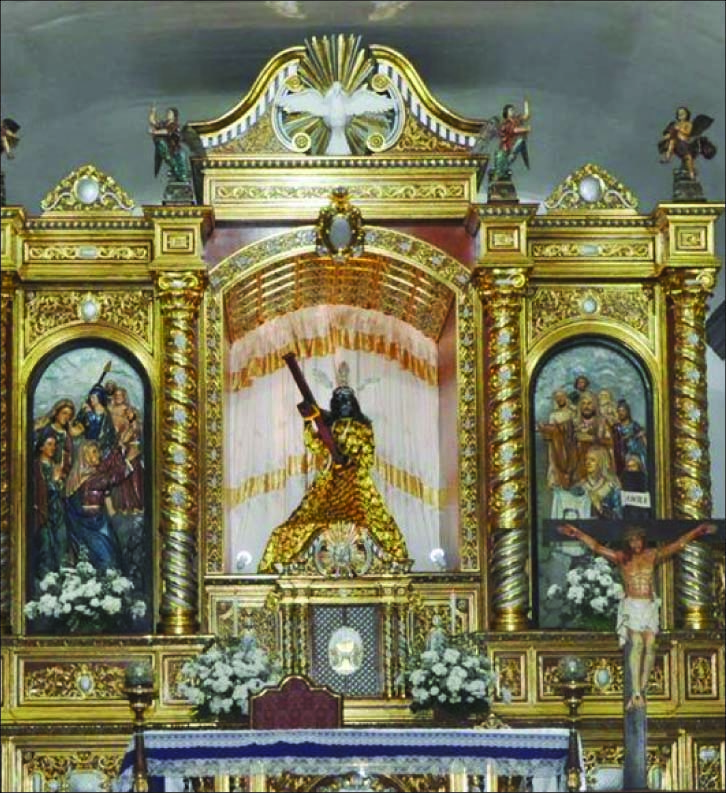First published in Tulay, Monthly Chinese-Filipino Digest 1, no. 7 (December 11, 1988): 8.
It’s Christmas, an occasion to remember the birth of Jesus Christ, the Nazarene. We chose for our cover this issue the picture of a little-known black Nazarene, who is worshiped mostly by Chinese in a mixture of Chinese and Catholic rites.
Image of the Poong Nazareno
Entering the church, one is immediately taken aback seeing the burning incense on the golden urn, the huge red candles with golden dragons carved on them, the Chinese lanterns, the divination sticks and the four Chinese characters 保王善士, read Pa-0ng-Sian-Si (in Hokkien phonetics), on the red embroidered Chinese mantel piece covering the altar.
For a brief while, one thinks that he has lost his way and entered a Chinese temple by mistake; if not for the big words Jesus Nazareno of Capalonga written outside.
Worshipers name the image Poong Jesus Nazareno. The four Chinese characters, Po-Ong Sian Si is a phonetical derivation — Po-Ong (保王) from the Tagalog word poon and Sian-si (善士) from the word saints. The literal meaning, however, is Po-ong (prince protector) and sian-si (noble man), in short, noble prince protector, an apt name for the prince of all men.
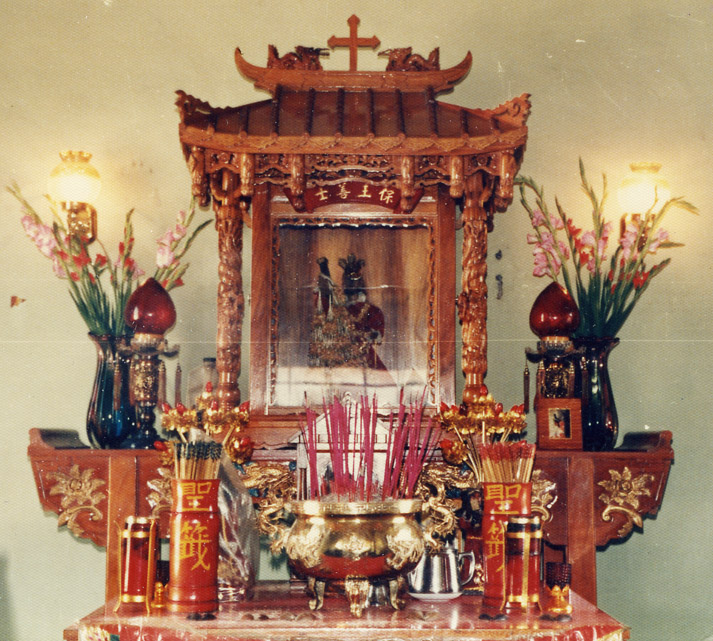
History of the image
Jesus Nazareno of Capalonga, Camarines Norte. Nobody could recall when this figure started to exist but most would claim that it existed during the early 16th century. The image became popular at the turn of the century and surprisingly, it was the Chinese who popularized the worship of the Nazareno. Capalonga is a remote, inaccessible town of Camarines Norte in the Bicol province, with a population of roughly 25,000.
How the Chinese came to worship this image is a story to be traced back during the Japanese occupation. The story was told to us by Tan Sun-hai, the person in charge of the Manila-based church of the Capalonga Nazarene (more about this Manila church later).
Tan recounted that Chinese guerrillas during the Japanese occupation sought refuge in a hut near the town. One of them was awakened by tickling and when he arose, he discovered that they were surrounded by Japanese soldiers.
There was no time to wake his companions up and he hid himself under the table beside where he was lying. He bumped into the wooden image of the Nazarene and begged for protection, promising to come back to pay homage and propagate belief in the image.
The guerrilla did survive the massacre which cost his companions’ lives. He told and retold his experience to other Chinese which started the yearly pilgrimage to Capalonga on May 21st, the feast day of the Nazareno.
The Chinese way of worshiping
The height of the pilgrimage was in the 1970s to 1980s. More than a hundred chartered air-conditioned tourist buses from Manila and other parts of Luzon find their way there. Chartered boats from the Visayas to as far as Mindanao also converge there. Those from Manila usually leave at about 7 a.m. or 8 a.m., arriving at mid- or late afternoon.
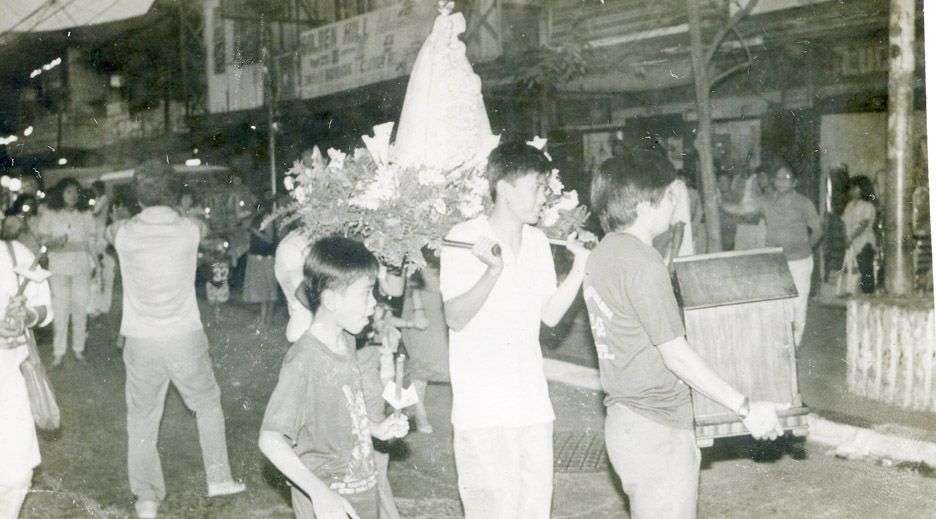
Lately, due to the insurgency problem, less and less pilgrimage tours are arranged each year. Some of the devotees talk about being stopped along the way by members of New People’s Army asking for tongs.
The celebration of the feast day is highlighted by the early morning procession which starts at 4 a.m. after mass is said. Thus, devotees have to go to Capalonga one day earlier and stay overnight either in the church pews or in the buses and the limited bed spaces rented out by the Capalonga townsfolk.
The original image of the Nazarene was at first placed in the Catholic church. However, the local parish priest later prevented the Chinese devotees from worshiping at the church because of the Chinese rites they observe.
The priest complained about the noise the Chinese create, even when high mass is being said. Moreover, the smoke from the incense and the noise made by the divination tablets and sticks annoy the Filipino worshipers.
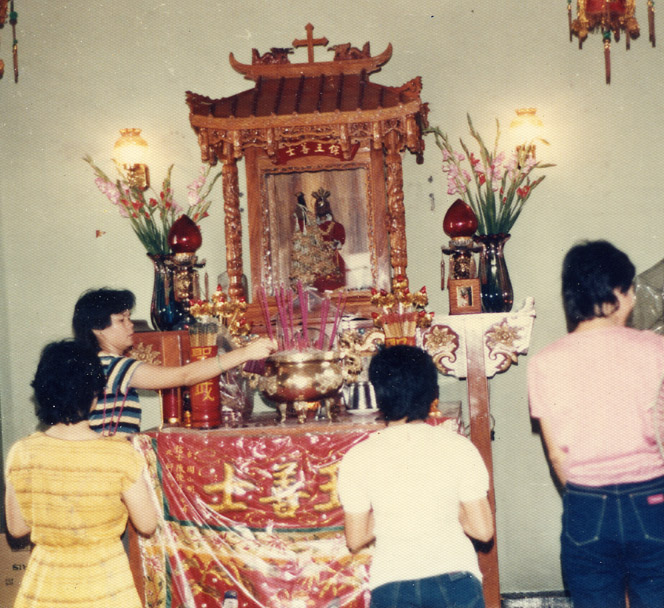
What the Chinese did, therefore, was to build another chapel at the back of the Catholic church. There, they made a bigger replica of the image of the black Nazarene. It is interesting to note that even Filipinos now go to the Chinese chapel to worship instead of to the Catholic church.
Instant answers to prayers
The main reason for the image’s popularity even among Filipinos is the incorporation of Chinese rites like the divination sticks which give instant answer to one’s plea.
A couple can ask for a child, for instance. Then, the couple, after burning incense, can ask God if their plea would be granted. The answer is given through the divination sticks.
Another reason is its effectiveness and stories of its miraculous manifestations in terms of prayers answered.
What do the Chinese usually ask for? They ask for blessings for their businesses and their families. They ask for help in times of business reversals or illness. Many have personal requests like finding a good wife, having children, succeeding in new ventures, and others.
The Chinese say that to be effective, meaning that one’s prayer will be answered, the pilgrimage must be undertaken for three consecutive years.
Bounty for Capalonga
The Chinese chapel is run by the Catholic parish priest. The generous contributions of the Chinese devotees go to the maintenance of such amenities as comfort rooms, clean pews where the devotees often lie down for much needed rest in time for the 4 a.m. procession the following day, and clean grounds.
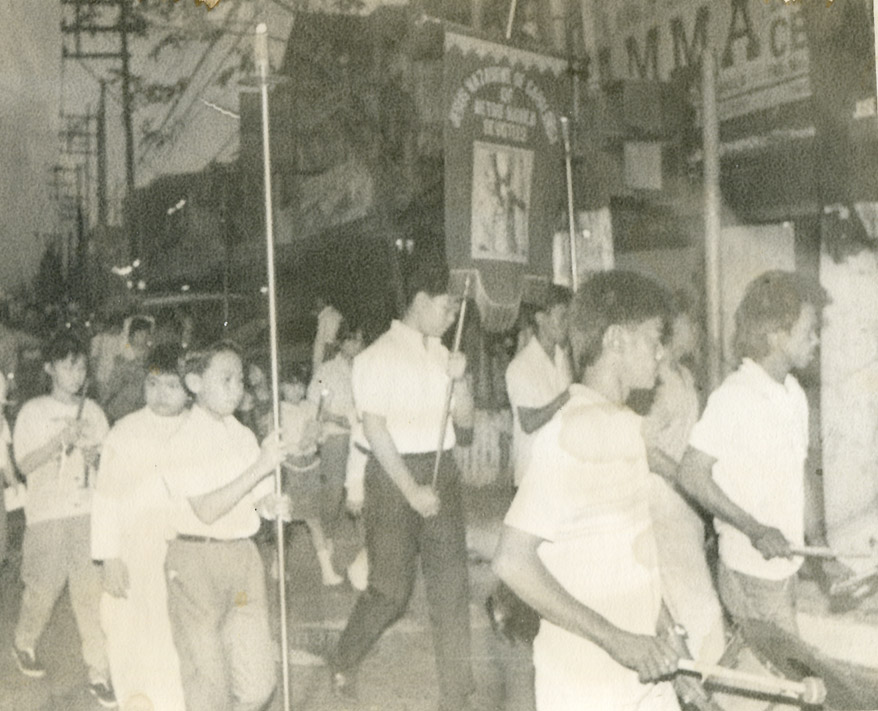
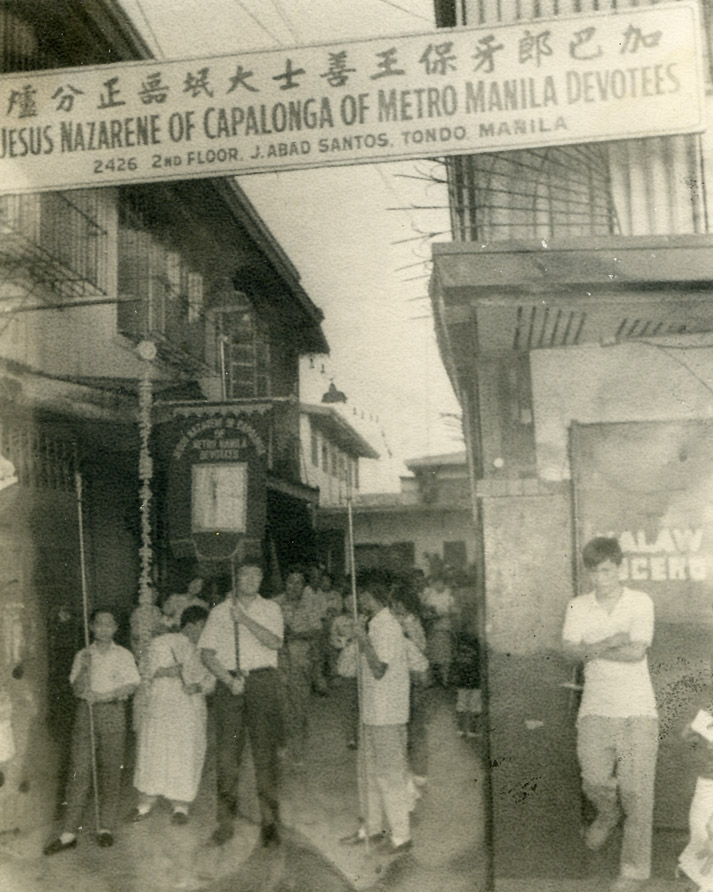
The considerable contributions also go to maintaining an elementary school in which the grounds double as parking space when the busloads and carloads of devotees come in May.
Going to Capalonga is a penance in itself. Those who do not have air-conditioned cars become blonde after the long eight-hour journey in the dusty, dirt road. Moreover, Capalonga hardly has any amenities for tourists.
The advent of Chinese worshippers helped to wake up its inhabitants. Many rent out bed spaces to the worshipers who had to stay overnight for the early morning procession. Others sell food, soft drinks and small images of the Nazareno or Sto. Niño.
The Manila-based branch
In 1980, when pilgrimages to Capalonga was starting to dwindle, some devotees thought of putting up a Manila branch of the Jesus Nazareno of Capalonga. It is located at the second floor of a wooden house in busy Jose Abad Santos St. in Tondo right after the railroad.
The original image of the Nazarene is placed there, below the main altar where a bigger replica of the black Nazarene is displayed behind the glass case.
The feast day of the Manila Nazarene is Nov. 30. The day is celebrated after a nine-day novena starting on Nov. 21. The celebration is also capped by a procession after which a mass is said by the parish priest of San Roque to which the Tondo chapel belongs.
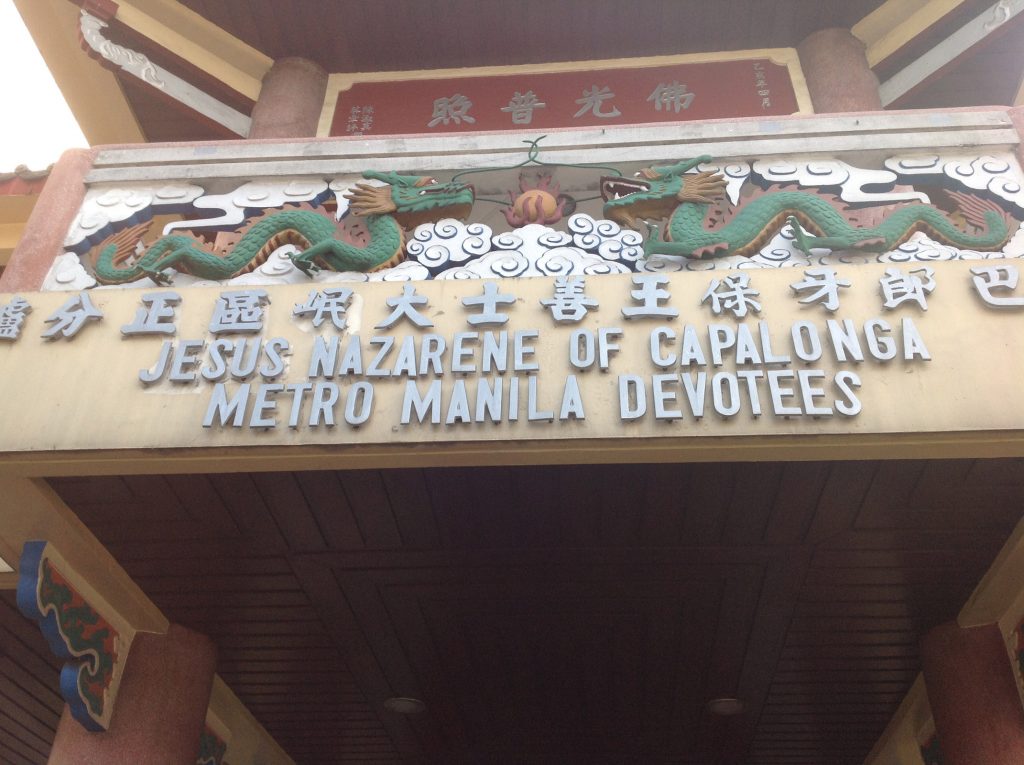
The Philippine-Chinese practice
Most of the devotees to the Nazarene are not even Catholics. They are mostly Buddhists or Taoists who observe Catholic faith nominally. This kind of religious syncretism manifested in the worship of the black Nazarene in the Chinese way exists in many aspects of Chinese life because of the Chinese concept of religion.
The Philippine-Chinese community is predominantly a business community. Being one, it is very practical. The ups and downs of business with all its uncertainties become fertile grounds for instilling and strengthening superstitious as well as religious beliefs.
The Chinese believe that all religions are good, they all teach men to be good, so there is nothing wrong in embracing more than one faith. At the same time, they believe that anything that brings luck and good fortune must be true and must be observed.
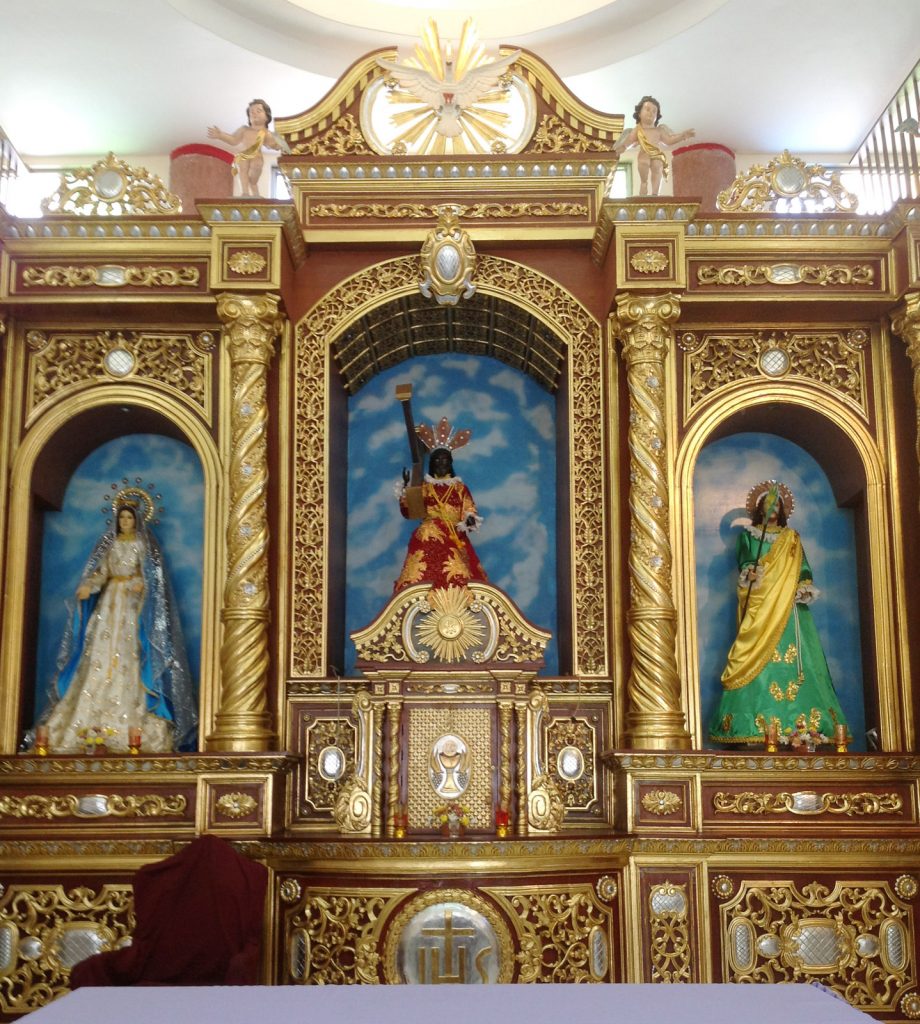
The rule of the thumb is if it cannot be proven that a spirit does not exist, then you have to believe in the positive aspect, it exists. The same rule holds true for their outlook on misfortunes, on faiths and even on superstitions — if the contrary is doubtful, then it is safe to believe that it is caused by spirits, good or bad. It is not surprising, therefore, that syncretism occurs. Since it is safer to believe than not to believe, having several beliefs and faiths at the same time becomes understandable.
Lim Punzong, a worshipper of the image of the Virgin Mary in Batangas which is being worshiped at the same time as the Chinese Ma-Tzu, explained it well: on earth, it does not matter how many kinds of religion or faiths there are — there is Sakyamuni, there is Mohammed, there is Jesus Christ — but in heaven, there is only one universal spirit.
The different religious figures on earth are all manifestations (化身 Hua shen) of that one Universal Spirit; after all, all faiths and religion have only one purpose — to propagate goodness among mankind.
Following this principle, the Philippine-Chinese also believe in only one universal spirit — the one which brings them good fortune and help them earn money. This “money spirit” can also have different manifestations and there can be many ways of worshiping it.
The one overriding factor is that the guiding spirit is benevolent and effective, that it works miracles and bring good fortune to them. Amen!
